MARITIMES BIRDING EXPEDITIONS
(with naturalist and birding guide)
Quebec ~ New Brunswick ~ Nova Scotia
Prince Edward Island ~ Newfoundland including Labrador
Tour Description
Part 1 - 49 Day Tour - May 30 to July 17, 2009
Part 2 - 35 Day Tour - July 26 to August 29, 2009
For
incredible natural beauty, great birding, intriguing history, entertaining
culture and mouthwatering
cuisine, a trip to the Canadian Maritimes cannot be beat.
Part 1. Spring migration and summer nesting
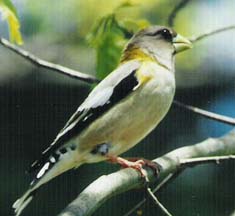 Our two back-to-back trips will make a grand sweep through the
eastern seaboard provinces, the first following the spring migration of birds
eager to reach their nesting grounds, the second timed to meet fall migration at
its peak. We'll visit a gannet colony on a coastal island just as 70 000
adults are attending nests spaced so close together the sitting birds almost
touch bills and from our viewpoint we'll be almost as close. From pelagic
trips we'll watch Atlantic Puffins flying to and from their
nesting burrows. Along dramatic seaside cliffs we'll find Great Cormorants
on nests clinging to the rock ledges, and in inland boreal forests we'll seek
out Spruce and Ruffed grouse, Boreal Chickadees, Bay-breasted and Blackburian
warblers and Evening Grosbeaks. Our visits to salt marshes will show us
Nelson's Sharp-tailed Sparrow and nesting Common Terns and the freshwater
marshes will be replete with geese and ducks. On the pelagic ferry trips
connecting Newfoundland we'll have hours to scan for shearwaters, storm-petrels
and jaegers.
Our two back-to-back trips will make a grand sweep through the
eastern seaboard provinces, the first following the spring migration of birds
eager to reach their nesting grounds, the second timed to meet fall migration at
its peak. We'll visit a gannet colony on a coastal island just as 70 000
adults are attending nests spaced so close together the sitting birds almost
touch bills and from our viewpoint we'll be almost as close. From pelagic
trips we'll watch Atlantic Puffins flying to and from their
nesting burrows. Along dramatic seaside cliffs we'll find Great Cormorants
on nests clinging to the rock ledges, and in inland boreal forests we'll seek
out Spruce and Ruffed grouse, Boreal Chickadees, Bay-breasted and Blackburian
warblers and Evening Grosbeaks. Our visits to salt marshes will show us
Nelson's Sharp-tailed Sparrow and nesting Common Terns and the freshwater
marshes will be replete with geese and ducks. On the pelagic ferry trips
connecting Newfoundland we'll have hours to scan for shearwaters, storm-petrels
and jaegers.
With great care, these trips are timed to be at the
right place at the right time, optimally catching migration windows and nesting
cycles. We've even aligned the schedule to give us the best time to see
icebergs in Newfoundland and the highest concentration of moose where they
gather on the island.
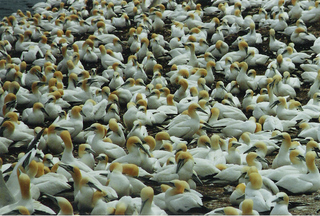 Our trip starts in historic Quebec City where we will visit
marshlands along the St. Lawrence River just as tens of thousands of Greater
Snow Geese stage during migration. From there we circle the awesome
Gaspé Peninsula, the northeast extension of the Appalachian Mountains
surrounded by sea on three sides. Off the rugged mainland, near Percé
Rock, is where Jacques Cartier landed in July 1534, claiming for France what
would become Canada. Now we visit the area to see the hundred thousand
birds that feed and nest at Bonaventure Island, including the world's second
largest Northern Gannet colony.
Our trip starts in historic Quebec City where we will visit
marshlands along the St. Lawrence River just as tens of thousands of Greater
Snow Geese stage during migration. From there we circle the awesome
Gaspé Peninsula, the northeast extension of the Appalachian Mountains
surrounded by sea on three sides. Off the rugged mainland, near Percé
Rock, is where Jacques Cartier landed in July 1534, claiming for France what
would become Canada. Now we visit the area to see the hundred thousand
birds that feed and nest at Bonaventure Island, including the world's second
largest Northern Gannet colony.
Blending historic and cultural sites with excellent birding
opportunities will be a regularly occurring theme throughout the trip.
Thus one of our next stops is at Caraquet, where we can visit fascinating
Acadian Historical Village and in the same area tour the birding habitats of New
Brunswick's "Land's End" where the two islands Miscou and Laméque reach into the
Gulf of St. Lawrence. Canada's National Parks are among the many birding
places we will visit. In New Brunswick we spend a couple of days at
Kouchibouguac National Park and in the next province it will be Prince
Edward Island National Park. After spending even one day on Prince
Edward Island, you will become aware of Anne of Green Gables. This famous
red-headed orphan is everywhere and we will get immersed in her persona as well.
We will end our stay on PEI at the Confederation Centre of the Arts and can
attend (optional) the delightful family musical about Anne, her childhood, young adulthood
and romance with Gilbert Blythe. But before we've left the island we will
have visited the dramatic cliffs that are nesting home to Great Cormorants and
the sand beaches and saltwater bays of this picturesque province. We'll
also take a ferry to Magdalen Islands (Iles de la Madeleine) archipelago, seeing Greater
Shearwater, Leach's Storm-Petrel and other pelagic birds in route, then staying
two nights at an island hotel so that we will have plenty of time to explore the
red sandstone islands and their Beachgrass dunes, tidal lagoons and stunted
spruce-pine uplands. Described as a unique spot for birders, this side
trip from our RV's is included in our tour and one we're sure you'll look
forward to.
Newfoundland
has the allure of Alaska, but on the opposite end of the continent. An
island so remote from the mainland that the "short" ferry to Port aux Basques
takes 5-7 hours and the return ferry from St. John's is 14 hours. All the
better for birders, as we can view pelagic birds, whales and dolphins throughout
the Atlantic Ocean ferry ride from the deck or, if you prefer, enjoy the
comforts inside the spacious ship. After arriving, we'll tread our way
northward along the Gulf of St. Lawrence coastline, birding along the way the
next few days.
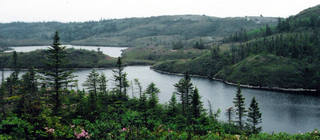 We want to reach St. Anthony at the northeastern tip
of Newfoundland in time to see icebergs before they drift off toward Greenland.
We'll also make an early morning visit to a site where we found an amazing 24
moose on a previous trip. One late afternoon and early evening, we'll
attend the Viking Feast: while dining on an array of scrumptious local
dishes not found just anywhere - have you ever had moose stew? - you will be
entertained by a humorous look at Viking life. Held in Leifsburdir, a replica of
Lief Ericson’s home in Newfoundland, complete with sod roof, you will be
transformed back 1000 years to a time when the Vikings roamed the land.
And, we'll visit the original site of the Viking landing at L'Anse aux
Meadows, which turns out to be a good birding spot as well.
We want to reach St. Anthony at the northeastern tip
of Newfoundland in time to see icebergs before they drift off toward Greenland.
We'll also make an early morning visit to a site where we found an amazing 24
moose on a previous trip. One late afternoon and early evening, we'll
attend the Viking Feast: while dining on an array of scrumptious local
dishes not found just anywhere - have you ever had moose stew? - you will be
entertained by a humorous look at Viking life. Held in Leifsburdir, a replica of
Lief Ericson’s home in Newfoundland, complete with sod roof, you will be
transformed back 1000 years to a time when the Vikings roamed the land.
And, we'll visit the original site of the Viking landing at L'Anse aux
Meadows, which turns out to be a good birding spot as well.
Labrador is our next stop. Leaving our RV's at
St. Barbe, the ferry will take us to Quebec, while we scan for Northern Fulmars,
and within minutes after debarking we will cross into Labrador. An
overnight hotel stay will give us enough time to explore the many coves and bays
along the rugged marine coast of southern Labrador, including the village of Red
Bay where we can see the remains of an ancient Basque whaling station.
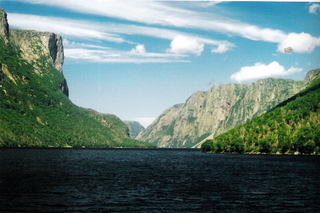 Gros Morne National Park - mountains and valleys, the
remnants of past ice ages - looms tall away from the coastal shore and on a hike
to 540-ft deep Western Brook Pond we can wonder at the 2200-ft. massive rock
walls where Herring Gulls nest on crevices. Numerous waterfalls pour thin
ribbons from alpine mountaintops, dropping vertically for hundreds of feet,
splashing bridal veils on rocks and then plunging again and again until the
streams round out near the bottom and spread into the lake.
Gros Morne National Park - mountains and valleys, the
remnants of past ice ages - looms tall away from the coastal shore and on a hike
to 540-ft deep Western Brook Pond we can wonder at the 2200-ft. massive rock
walls where Herring Gulls nest on crevices. Numerous waterfalls pour thin
ribbons from alpine mountaintops, dropping vertically for hundreds of feet,
splashing bridal veils on rocks and then plunging again and again until the
streams round out near the bottom and spread into the lake.
From Gros Morne we head inland to central Newfoundland and
bird the boreal forest and open barrens of The Exploits region for
warblers such as Blackpoll, Palm Warbler, Northern Waterthrush and Wilson's
Warbler, and other nesting birds that can include Boreal Chickadee and Rusty
Blackbird. You'll be entranced by the charming seascapes viewed from our
next campsite at Twillingate. Even the village name sounds magical.
Along the beach, tide pools collect tiny fish, sand shrimp, periwinkles and
urchins. On our last visit we found both Blue Mussels and the larger, redder
Horse Mussels, tough creme-colored Greenland Cockles, large rotund Moon Snails
and a type of brain coral that adheres to small rocks and mussels.
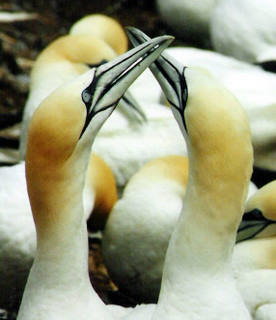 Now
following the Atlantic Ocean shore we'll camp and bird at Terra Nova National
Park and then tour the coves and coastal shores of Bonavista Peninsula,
terminating at a tiny rock island where Atlantic Puffins stand erect like
tuxedoed penguins next to their earthy nesting burrows and others return from
the sea, carrying fish in their bills, gliding in for a landing like bulbous
bombers.
Now
following the Atlantic Ocean shore we'll camp and bird at Terra Nova National
Park and then tour the coves and coastal shores of Bonavista Peninsula,
terminating at a tiny rock island where Atlantic Puffins stand erect like
tuxedoed penguins next to their earthy nesting burrows and others return from
the sea, carrying fish in their bills, gliding in for a landing like bulbous
bombers.
Continuing to southern Newfoundland we'll reconnoiter Avalon
Peninsula and spend a day at Cape St. Mary's Seabird Sanctuary, perhaps
the most memorable birding stop in the province because of the densely nesting
gannets, razorbills, murres and kittiwakes that cling to the high seaside
cliffs.
Our final stop in Newfoundland is St. John's. On a boat
trip through Witless Bay Ecological Reserve Atlantic Puffins will be
plentiful and likely to be observed at the same time we are watching Humpback
Whales. We'll ask the captain to get close to the islands and maybe we can
get good photos of Razorbills.
The 49th day is the ferry trip departing from Argentia.
For those continuing on for Part 2 of this Maritimes adventure - and we expect
most of you will want to do both parts - you'll likely want to stay in
Newfoundland longer. That's one reason for the 8-day break between trips.
St. John's is a wonderful place to enjoy Newfoundland's culture and is
the heart of dozens of good birding spots all within an easy drive of our
campsite. Or, you can visit Burin Peninsula and, perhaps, even take a day
ferry to the French islands of St. Pierre et Miquelon. Most of you will
want to depart on the Argentia ferry with our Wagonmasters and birding guide who
will help you identify the pelagic birds on the voyage to Nova Scotia, arriving
in time for the start of Part 2.
Part 2. Fall migration
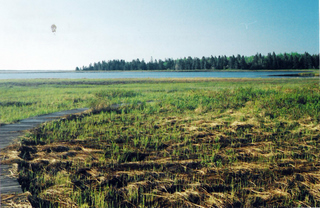 Again, timing is everything and our schedule puts us in the
best habitats at the peak of fall shorebird migration. Songbirds will
still be at nesting sites, so we'll stop at those birding spots too.
Again, timing is everything and our schedule puts us in the
best habitats at the peak of fall shorebird migration. Songbirds will
still be at nesting sites, so we'll stop at those birding spots too.
We rendezvous at North Sydney, Nova Scotia, in a campground
not far from where the ferry returns from Newfoundland. Our first
excursion is to the Fortress of Louisbourg National Historic Site,
described as the finest reconstructed historic site in North America and at the
same time offers birding attractions along its harbor, beach and cove.
Here we can step into 18th century Canadian colonial history, strolling the
grounds of the fortress surrounded by dozens of costumed residents of the summer
of 1744.
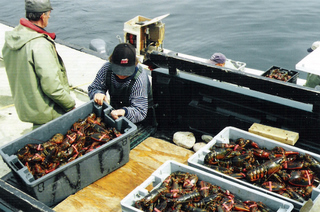 We move to a campsite on Cape Breton and will have three days
to drive the Cabot Trail, hike the trails of the Cape Breton Highlands
National Park and, optionally, take a boat trip to Bird Island to watch
Atlantic Puffins. The largest concentration of Bald Eagles in northeastern
North America nest at Bras d'Or Lake, not far from our campsite.
We move to a campsite on Cape Breton and will have three days
to drive the Cabot Trail, hike the trails of the Cape Breton Highlands
National Park and, optionally, take a boat trip to Bird Island to watch
Atlantic Puffins. The largest concentration of Bald Eagles in northeastern
North America nest at Bras d'Or Lake, not far from our campsite.
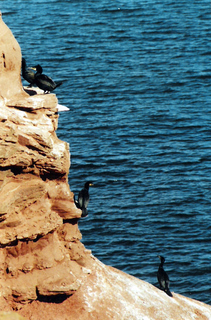 Rounding
the cape, we'll scan for Northern Gannets diving off the coast and see Great
Black-backed Gulls, Arctic Terns and Black Guillemots. On the inland
trails through the forests with luck we might find one of the few and rare
Bicknell's Thrushes that nest on the cape.
Rounding
the cape, we'll scan for Northern Gannets diving off the coast and see Great
Black-backed Gulls, Arctic Terns and Black Guillemots. On the inland
trails through the forests with luck we might find one of the few and rare
Bicknell's Thrushes that nest on the cape.
Just in time for the peak of sandpiper migration, our next
stop is near the mudflats of the Bay of Fundy. They say 100,000
Semipalmated Sandpipers pass through this bay and we have an excellent chance of
seeing half that number in a single flock. Imagine seeing so many
stretched across the mudflats and all taking flight at once in waves of blurred
wings when a young Peregrine Falcon vainly tries to snag one in its talons.
Along the tidal rivers the salt marshes in this area are a good place for us to
find nesting Nelson's Sharp-tailed Sparrows.
We'll swing back into central Nova Scotia, travel through
Annapolis Valley and wrap around Minas Basin where we can see the bore
tide that sometimes is a mere ripple and other times a wall of rushing water.
The advancing tide concentrates shorebirds into large flocks and eventually
forces them to fly inland to roost. Our stop at Halifax will have
you splitting your time between seeing the wonderful sights of this beautiful
harbor city and birding the coastline, but with four nights here you'll have
time to enjoy both and even include a trip to famously picturesque Peggy's
Cove.
From Halifax we head inland to camp in the boreal forests of
Kejimkujik National Park seeking Spruce Grouse along its many trails,
hearing and seeing Common Loons on Kejimkujik Lake. From here we drive a
short distance to the harbor at Digby. We're in good time to follow the
fall migration corridor along Digby Neck, taking several short ferry rides all
the way out to Brier Island, considered one of the premier birding sites
in the province. The rugged coastline is a good vantage point to watch
passing gannets, kittiwakes, dovekies, Common and Thick-billed murres, and other
seagoing birds.
Our second trip continues our immersion into unique cultures.
Nova Scotia means New Scotland in Latin and the Scottish influence cannot be
denied. Immigrants from Ireland and Scotland came by the thousands in the 18th
and 19th leaving their Gaelic culture to this day. Hopefully we will come across
a fiddle contest or a bagpipe serenade. We will come to understand “Ciad Mile
Failte” the Gaelic “One hundred thousand welcomes." We will also find French
influence and the tragic Acadian history and culture. Not to be forgotten, we
can visit the Mi’kmaq petroglyphs in Kejimkujik National Park and get an
understanding of the aboriginal people of 1000s of years past.
After Digby Neck, it's time to head to New Brunswick, first to Hopewell Cape
and then to Fundy National Park. We'll need to visit Hopewell
Rocks at low tide so that we can walk the gravelly beach area beneath the
towering pillars and then return at high tide to marvel at the incredible change
in water level up to 46 ft. in height. The sandpipers will still be
flocking and feeding on the mudflats and now we'll see them from the other side
of the Bay of Fundy. Even three nights at the national park will seem too
short a time to explore the multiple birding habitats and enjoy the broad view
of the bay. From there we move to Grand Manan Archipelago, putting
our RV's on a ferry to the islands to enjoy four nights at New Brunswick's
preeminent birding destination, famous since John James Audubon visited in 1833.
The archipelago is the best place to watch whales in August. With its
extremely diverse habitats and a checklist of over 350 bird species, we will be
ending our birding tours at a high point and will celebrate at the farewell
dinner.
SPECIAL: This is an exclusive caravan, limited to only ten customer rigs
(plus one or two extras to allow for later cancellations) and less than
half the size of most caravans. Based on customer surveys we are restricting the size of
our group. This gives the distinct advantage of easier caravan travel and parking, and
more flexibility on side trips and accommodations at great birding spots not available to
traditional caravan sizes. Greater attention from the birding guides, the social directors
and the staff significantly enhances the value of this specialized caravan trip.
This web site is designed by Bert Frenz.
Copyright © 2007-08 Bert Frenz. All rights reserved.
Revised: July 21, 2008.
 Our two back-to-back trips will make a grand sweep through the
eastern seaboard provinces, the first following the spring migration of birds
eager to reach their nesting grounds, the second timed to meet fall migration at
its peak. We'll visit a gannet colony on a coastal island just as 70 000
adults are attending nests spaced so close together the sitting birds almost
touch bills and from our viewpoint we'll be almost as close. From pelagic
trips we'll watch Atlantic Puffins flying to and from their
nesting burrows. Along dramatic seaside cliffs we'll find Great Cormorants
on nests clinging to the rock ledges, and in inland boreal forests we'll seek
out Spruce and Ruffed grouse, Boreal Chickadees, Bay-breasted and Blackburian
warblers and Evening Grosbeaks. Our visits to salt marshes will show us
Nelson's Sharp-tailed Sparrow and nesting Common Terns and the freshwater
marshes will be replete with geese and ducks. On the pelagic ferry trips
connecting Newfoundland we'll have hours to scan for shearwaters, storm-petrels
and jaegers.
Our two back-to-back trips will make a grand sweep through the
eastern seaboard provinces, the first following the spring migration of birds
eager to reach their nesting grounds, the second timed to meet fall migration at
its peak. We'll visit a gannet colony on a coastal island just as 70 000
adults are attending nests spaced so close together the sitting birds almost
touch bills and from our viewpoint we'll be almost as close. From pelagic
trips we'll watch Atlantic Puffins flying to and from their
nesting burrows. Along dramatic seaside cliffs we'll find Great Cormorants
on nests clinging to the rock ledges, and in inland boreal forests we'll seek
out Spruce and Ruffed grouse, Boreal Chickadees, Bay-breasted and Blackburian
warblers and Evening Grosbeaks. Our visits to salt marshes will show us
Nelson's Sharp-tailed Sparrow and nesting Common Terns and the freshwater
marshes will be replete with geese and ducks. On the pelagic ferry trips
connecting Newfoundland we'll have hours to scan for shearwaters, storm-petrels
and jaegers. Our trip starts in historic Quebec City where we will visit
marshlands along the St. Lawrence River just as tens of thousands of Greater
Snow Geese stage during migration. From there we circle the awesome
Gaspé Peninsula, the northeast extension of the Appalachian Mountains
surrounded by sea on three sides. Off the rugged mainland, near Percé
Rock, is where Jacques Cartier landed in July 1534, claiming for France what
would become Canada. Now we visit the area to see the hundred thousand
birds that feed and nest at Bonaventure Island, including the world's second
largest Northern Gannet colony.
Our trip starts in historic Quebec City where we will visit
marshlands along the St. Lawrence River just as tens of thousands of Greater
Snow Geese stage during migration. From there we circle the awesome
Gaspé Peninsula, the northeast extension of the Appalachian Mountains
surrounded by sea on three sides. Off the rugged mainland, near Percé
Rock, is where Jacques Cartier landed in July 1534, claiming for France what
would become Canada. Now we visit the area to see the hundred thousand
birds that feed and nest at Bonaventure Island, including the world's second
largest Northern Gannet colony. We want to reach St. Anthony at the northeastern tip
of Newfoundland in time to see icebergs before they drift off toward Greenland.
We'll also make an early morning visit to a site where we found an amazing 24
moose on a previous trip. One late afternoon and early evening, we'll
attend the Viking Feast: while dining on an array of scrumptious local
dishes not found just anywhere - have you ever had moose stew? - you will be
entertained by a humorous look at Viking life. Held in Leifsburdir, a replica of
Lief Ericson’s home in Newfoundland, complete with sod roof, you will be
transformed back 1000 years to a time when the Vikings roamed the land.
And, we'll visit the original site of the Viking landing at L'Anse aux
Meadows, which turns out to be a good birding spot as well.
We want to reach St. Anthony at the northeastern tip
of Newfoundland in time to see icebergs before they drift off toward Greenland.
We'll also make an early morning visit to a site where we found an amazing 24
moose on a previous trip. One late afternoon and early evening, we'll
attend the Viking Feast: while dining on an array of scrumptious local
dishes not found just anywhere - have you ever had moose stew? - you will be
entertained by a humorous look at Viking life. Held in Leifsburdir, a replica of
Lief Ericson’s home in Newfoundland, complete with sod roof, you will be
transformed back 1000 years to a time when the Vikings roamed the land.
And, we'll visit the original site of the Viking landing at L'Anse aux
Meadows, which turns out to be a good birding spot as well. Gros Morne National Park - mountains and valleys, the
remnants of past ice ages - looms tall away from the coastal shore and on a hike
to 540-ft deep Western Brook Pond we can wonder at the 2200-ft. massive rock
walls where Herring Gulls nest on crevices. Numerous waterfalls pour thin
ribbons from alpine mountaintops, dropping vertically for hundreds of feet,
splashing bridal veils on rocks and then plunging again and again until the
streams round out near the bottom and spread into the lake.
Gros Morne National Park - mountains and valleys, the
remnants of past ice ages - looms tall away from the coastal shore and on a hike
to 540-ft deep Western Brook Pond we can wonder at the 2200-ft. massive rock
walls where Herring Gulls nest on crevices. Numerous waterfalls pour thin
ribbons from alpine mountaintops, dropping vertically for hundreds of feet,
splashing bridal veils on rocks and then plunging again and again until the
streams round out near the bottom and spread into the lake. Now
following the Atlantic Ocean shore we'll camp and bird at Terra Nova National
Park and then tour the coves and coastal shores of Bonavista Peninsula,
terminating at a tiny rock island where Atlantic Puffins stand erect like
tuxedoed penguins next to their earthy nesting burrows and others return from
the sea, carrying fish in their bills, gliding in for a landing like bulbous
bombers.
Now
following the Atlantic Ocean shore we'll camp and bird at Terra Nova National
Park and then tour the coves and coastal shores of Bonavista Peninsula,
terminating at a tiny rock island where Atlantic Puffins stand erect like
tuxedoed penguins next to their earthy nesting burrows and others return from
the sea, carrying fish in their bills, gliding in for a landing like bulbous
bombers. Again, timing is everything and our schedule puts us in the
best habitats at the peak of fall shorebird migration. Songbirds will
still be at nesting sites, so we'll stop at those birding spots too.
Again, timing is everything and our schedule puts us in the
best habitats at the peak of fall shorebird migration. Songbirds will
still be at nesting sites, so we'll stop at those birding spots too. We move to a campsite on Cape Breton and will have three days
to drive the Cabot Trail, hike the trails of the Cape Breton Highlands
National Park and, optionally, take a boat trip to Bird Island to watch
Atlantic Puffins. The largest concentration of Bald Eagles in northeastern
North America nest at Bras d'Or Lake, not far from our campsite.
We move to a campsite on Cape Breton and will have three days
to drive the Cabot Trail, hike the trails of the Cape Breton Highlands
National Park and, optionally, take a boat trip to Bird Island to watch
Atlantic Puffins. The largest concentration of Bald Eagles in northeastern
North America nest at Bras d'Or Lake, not far from our campsite.
 Rounding
the cape, we'll scan for Northern Gannets diving off the coast and see Great
Black-backed Gulls, Arctic Terns and Black Guillemots. On the inland
trails through the forests with luck we might find one of the few and rare
Bicknell's Thrushes that nest on the cape.
Rounding
the cape, we'll scan for Northern Gannets diving off the coast and see Great
Black-backed Gulls, Arctic Terns and Black Guillemots. On the inland
trails through the forests with luck we might find one of the few and rare
Bicknell's Thrushes that nest on the cape.